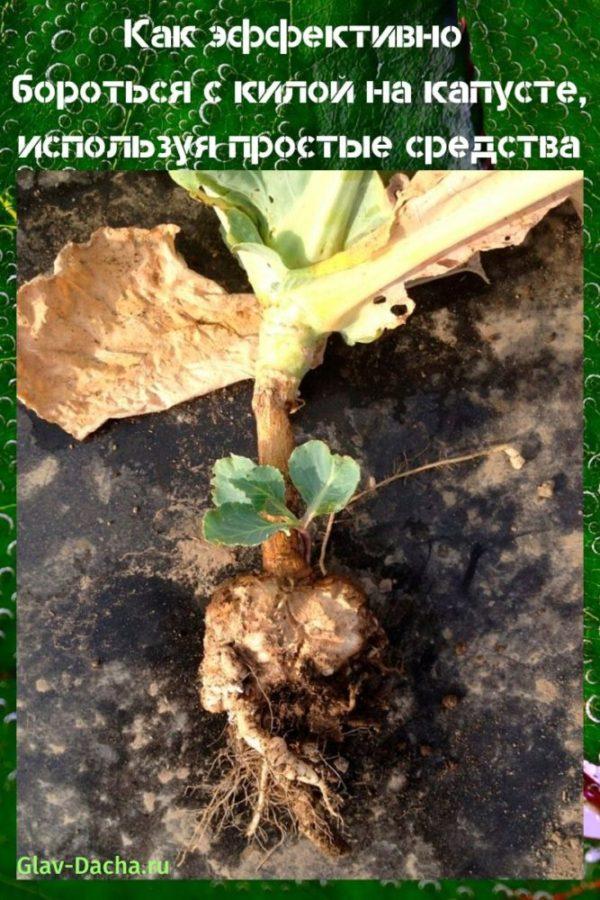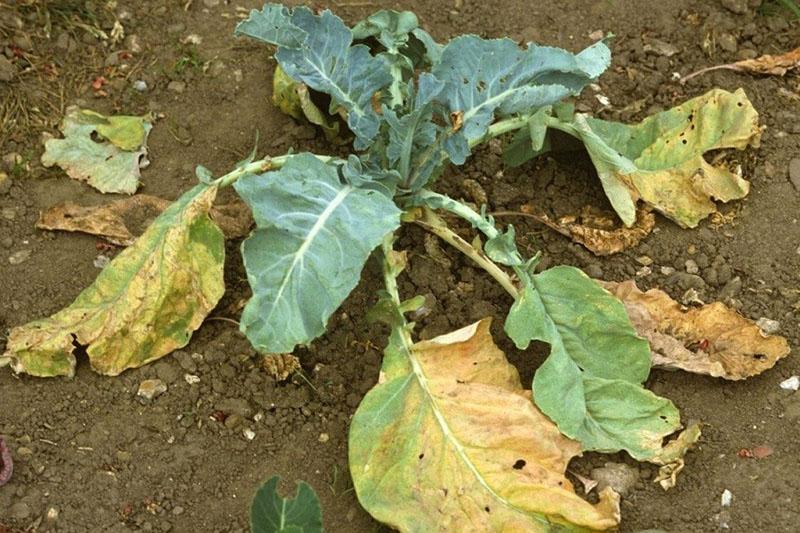How to effectively deal with keel on cabbage using simple remedies
 To grow a good harvest of cabbage, the gardener needs to make a lot of effort. In addition to proper care of the plant, reliable protection of the crop from dangerous diseases and harmful insects is also required. Plasmodiophora brassicae mushroom can reduce all work to zero. Therefore, it is important to know how to deal with keel on cabbage and not be afraid for the harvest of your favorite vegetable.
To grow a good harvest of cabbage, the gardener needs to make a lot of effort. In addition to proper care of the plant, reliable protection of the crop from dangerous diseases and harmful insects is also required. Plasmodiophora brassicae mushroom can reduce all work to zero. Therefore, it is important to know how to deal with keel on cabbage and not be afraid for the harvest of your favorite vegetable.
Biology of the causative agent of keela

With the beginning of spring, spores become more active and acquire a flagellum, and with it the ability to quickly move in the liquid phase of the soil. Moisture with a parasitic fungus penetrates into the root system through the hair roots. The infected cells begin to actively divide and increase in volume, taking nutrient compounds from the cabbage.
The plant can pick up the disease during the growing season, regardless of the season.
Signs of the disease
 At the initial stages of the development of the disease, most gardeners cannot diagnose a fungus on a vegetable crop, since the pathogen functions and develops on the root system. Therefore, the gardener continues to care for the plant, unaware of its infection.
At the initial stages of the development of the disease, most gardeners cannot diagnose a fungus on a vegetable crop, since the pathogen functions and develops on the root system. Therefore, the gardener continues to care for the plant, unaware of its infection.
In order not to face a fungal infection already in the last stages of cabbage keel and to start fighting it on time, you should study its main symptoms:
- Withering of the lower leaves of cabbage.
- Numerous growths, swelling on the roots. They are especially noticeable on adult plants, their size is from a pea to a fist. It is difficult to see them on seedlings: they look like small lumps of soil.
- A depressed view of the culture, yellowing of the foliage, the stunted growth of the head
- Gradual plant drying and death.

When the root system rots, the parasitic fungus forms a large number of new spores that go back into the soil and wait in the wings. Therefore, you should adhere to crop rotation and disinfect the soil.
Factors that contribute to the development of the fungus

Conditions that can cause the development of a microorganism in the area:
- increased acidity of the soil;
- introduction of fresh manure;
- the presence of plant residues of infected crops;
- non-compliance crop rotation;
- violation of care requirements: excessive watering, neglect of loosening.
Basically, the keel enters the garden through purchased seedlings, therefore, before purchasing, inspect the roots for the presence of seals.
Determination of soil contamination
 Before planting cabbage and other members of the Cruciferous family, it is necessary to test the soil for the presence of spores of the parasitic fungus. The check is carried out by planting Chinese cabbage on a selected area, which has a fast ripening period. Dig up the plant at different stages of development and carefully examine the roots. The presence of growths means that there are spores in the soil and before planting other crops it is better to disinfect the soil and re-test.
Before planting cabbage and other members of the Cruciferous family, it is necessary to test the soil for the presence of spores of the parasitic fungus. The check is carried out by planting Chinese cabbage on a selected area, which has a fast ripening period. Dig up the plant at different stages of development and carefully examine the roots. The presence of growths means that there are spores in the soil and before planting other crops it is better to disinfect the soil and re-test.
How to deal with keel on cabbage: technology for the destruction of a parasitic fungus
To get rid of keels on cabbage as quickly and efficiently as possible, you should use modern chemicals or sparing folk remedies.
Traditional methods
Traditional methods of treating cabbage keels, proven by our ancestors, will always be relevant, due to their effectiveness and safety:
- Infusion wood ash... Dilute 10 tbsp in 10 liters of water. substances and leave for 2 days. After 1 liter of infusion, dilute with 10 liters of water, mix. Each bush should get 0.5 liters of the composition. The procedure is carried out after watering. Loosen the cabbage to promote root growth at the top of the stem.

- Organic food. Every week, add fertilizers in the form of yeast, compost and mullein under the plant. The substances will help contain the activity and spread of the parasitic fungus.

- Lime solution. Dissolve 150 g of lime in 5 liters of water. Pour 500 ml of the product under each bush.

- Tops. The method is applied after harvest. To do this, scatter the beet and quinoa tops over the area where the affected crops previously grew, after crushing it, add organic matter and dig up the soil.

It will not be possible to cure cabbage with the help of folk remedies in the current season, all actions are aimed at safely suppressing the development of the fungus and preserving the harvest.
If it became known about the disease already at the last stage of the development of the fungus, then all affected heads of cabbage must be removed and burned, and the soil must be disinfected.
Chemicals

More effective and aggressive methods of dealing with cabbage keel are the use of chemicals:
- Trichodermin;
- Alirin B;
- Previkur;
- Fitosporin-M;
- Topaz;
- Fundazol.
The funds will not be able to completely remove the pathogen, but they will perfectly cope with inhibition of the development and reproduction of the parasitic organism.
When deciding to use chemicals, be sure to take care of personal protective equipment. If safety measures are not followed, hazardous substances can harm the body.
Preventive measures

Since dealing with keel on cabbage is not an easy task, you should worry in advance about protecting the culture by organizing proper care and not forgetting about preventive measures:
- When choosing seeds or seedlings of cabbage for planting, give preference to kilo-resistant varieties: Kilagreg, Kilaton, Nadezhda, Kilagerb, Tequila, Ramkila.
- Adhere to crop rotation and periodically plant plants in the garden bed, which leads to the death of the fungus. These are crops from the Pastel family: potatoes, eggplant, tomatoes, tobacco. They can resolve all disputes in 3 years. Also representatives of the Marevye family: spinach and beets, will help cleanse the soil from microorganisms in 2 years.

- Do not neglect the preparation of cabbage seeds before planting. Soak the material for 20 minutes in water at a temperature of 50 degrees, cool, dry and send it to a mustard solution (1.5%) for 6 hours.

- Before planting cabbage seedlings, treat the soil using a Fundazol solution (0.1%) or a special mixture based on 300 g of copper sulfate, 300 g of slaked lime and 8 liters of water.

- Timely remove weeds from the site, mainly shepherd's purse, field mustard, colza. These representatives of the Cabbage family are considered a refuge for fungal spores during the winter season.

- Experienced gardeners recommend planting cabbage in narrow beds. Such a move will allow you to quickly localize the disease and clear the soil from the parasitic microorganism.

Observing these requirements, you can improve the health of cabbage, get an excellent harvest of high quality, and increase the keeping quality of heads.
Knowing how to deal with keel on cabbage and protect the garden from disease damage, you can ensure a rich harvest of a healthy vegetable. A good result is possible only with strict adherence to all agrotechnical requirements of the crop for growing conditions. This will allow the plants to actively and successfully resist the fungal infection.